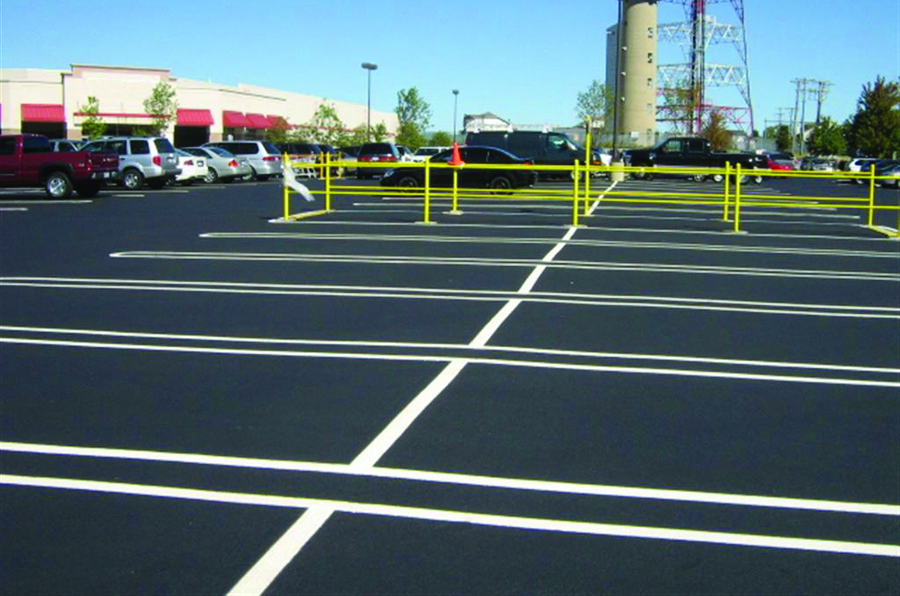A Closer Look at Sealcoating
Updated on 6/26/2024
Sealcoating is one of the most important elements of a pavement management plan. A sealcoat consists of either coal tar pitch or asphalt cement mixed with inert fillers, water, emulsifying agents, or additives.

Sealcoating is an essential component of any effective pavement management plan. This process involves applying a protective layer over asphalt surfaces, typically consisting of coal tar pitch or asphalt cement mixed with inert fillers, water, emulsifying agents, or other additives. This simple yet highly effective treatment can significantly extend the lifespan of your pavement, providing both protective and aesthetic benefits. In this comprehensive guide, we will delve deeper into the importance of sealcoating, explore its various benefits, and provide insights into the application process.
What is Sealcoating?
Sealcoating involves the application of a protective coating to asphalt-based pavements. This coating helps to shield the pavement from the damaging effects of weather, traffic, and other environmental factors. The materials used in sealcoating typically include:
- Coal Tar Pitch: Known for its durability and resistance to various chemicals, coal tar pitch is a common choice for sealcoating.
- Asphalt Cement: This binder, mixed with other ingredients, forms a resilient seal that can withstand the elements.
- Inert Fillers: These materials help to fill in small cracks and imperfections, providing a smoother surface.
- Water and Emulsifying Agents: These help to evenly distribute the sealcoat and ensure proper adhesion.
- Additives: These can enhance the performance of the sealcoat, providing additional protection or improving the application process.
The Benefits of Sealcoating
1. Protection and Longevity
One of the primary reasons for sealcoating is to protect and prolong the life expectancy of your pavement. By sealing over the liquid asphalt cement that binds the aggregate and fines within the pavement, sealcoating prevents the surface from becoming porous and separating along seams and cracks. This protective barrier helps to guard against the damaging effects of water, UV rays, oil, and chemicals, all of which can cause the asphalt to deteriorate over time.
2. Aesthetic Appeal
A freshly sealed and striped parking lot creates an excellent first impression. Over time, the surface of asphalt pavement can oxidize and fade, resulting in a gray and worn appearance. Sealcoating restores the pavement’s vibrant black finish, providing a striking contrast to pavement markings and enhancing the overall aesthetic appeal of your property.
3. Cost-Effectiveness
Regular sealcoating can save you money in the long run. By extending the life of your pavement, you can delay the need for costly repairs or replacement. The cost of sealcoating is relatively low compared to the expense of major pavement rehabilitation, making it a wise investment for property owners.
4. Improved Safety
Sealcoating not only enhances the appearance of your pavement but also improves safety. A smooth, well-maintained surface reduces the risk of accidents and injuries caused by uneven or cracked pavement. Additionally, the clearly defined pavement markings that result from sealcoating can help to direct traffic and improve overall safety for drivers and pedestrians.
The Sealcoating Process
The sealcoating process involves several key steps to ensure a durable and effective application:
1. Surface Preparation
Before applying the sealcoat, it is essential to prepare the surface properly. This involves cleaning the pavement to remove any dirt, debris, or oil stains. Cracks and potholes should be repaired to provide a smooth and even surface for the sealcoat.
2. Application
The sealcoat is typically applied using a spray, squeegee, or brush. The method chosen will depend on the specific requirements of the pavement and the preferences of the contractor. It is essential to apply the sealcoat evenly and at the correct thickness to ensure optimal protection.
3. Curing
After application, the sealcoat needs time to cure. This process can take several hours to a few days, depending on the weather conditions. During this time, it is important to keep traffic off the pavement to allow the sealcoat to set properly.
4. Final Touches
Once the sealcoat has cured, the final touches can be added. This typically involves reapplying pavement markings, such as parking lines and directional arrows, to enhance safety and functionality.
Eco-Friendly Alternatives
For those interested in more environmentally friendly options, there are eco-friendly alternatives to traditional sealcoat products. These alternatives use sustainable materials and processes to provide the same protective benefits without the environmental impact. By choosing an eco-friendly sealcoat, you can help to reduce your carbon footprint while still maintaining the integrity and appearance of your pavement.
Conclusion
Sealcoating is a vital part of maintaining and preserving your asphalt pavement. From protecting against the elements to enhancing curb appeal and improving safety, the benefits of sealcoating are numerous. Whether you manage a commercial property or simply want to keep your driveway in top condition, regular sealcoating is a wise investment.
For more information and facts on sealcoating, including a look at its benefits and application techniques, visit Rose Paving. Got a specific question about sealcoating? Comment below or contact one of our parking lot experts at (888) 773-ROSE.
Interested in an eco-friendly alternative to traditional sealcoat? Click here to learn more!
Ready to protect and enhance your pavement? Contact Rose Paving today to schedule your sealcoating service! Visit Rose Paving to get started.




